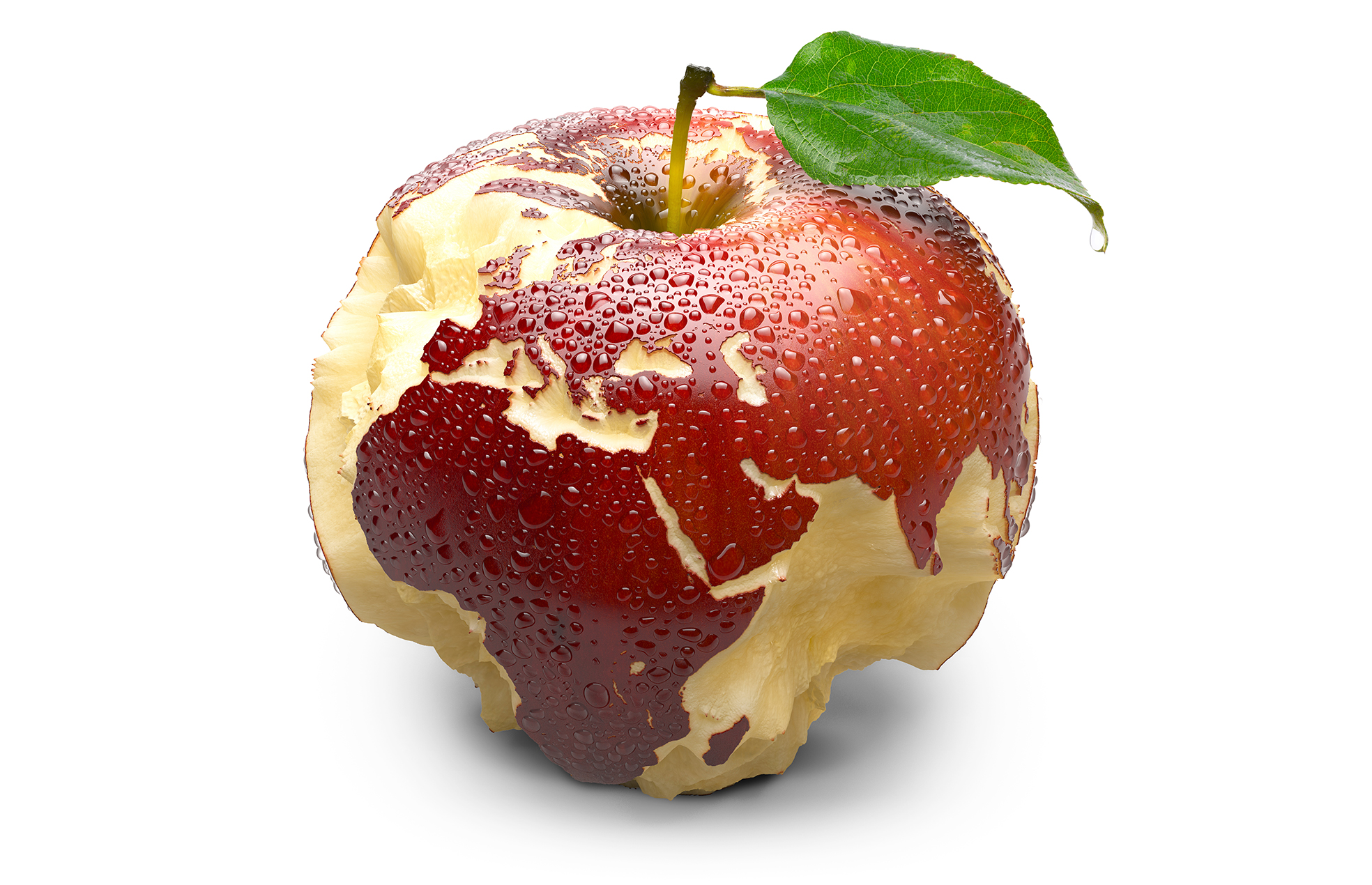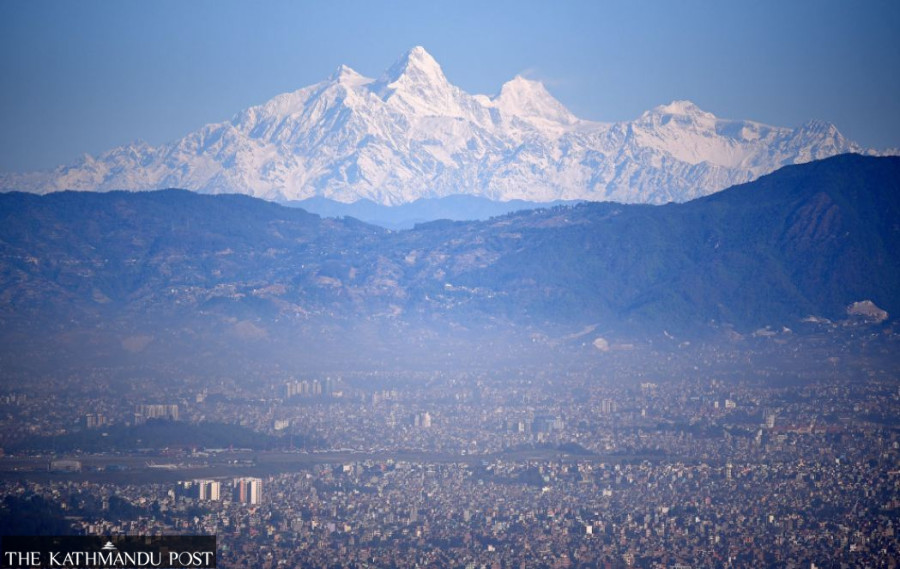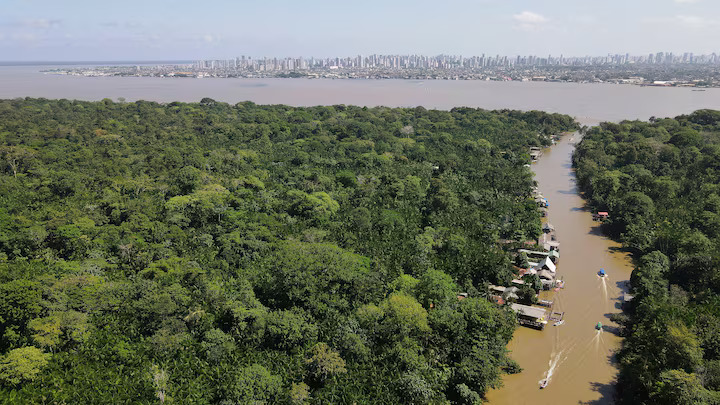Climate & Environment
How climate change is altering apple farming across Mustang
Hotter temperatures and erratic rainfall are wreaking havoc on—and redrawing the agricultural map in—Nepal’s apple capital.
Chase Brush
Needarshan Thakali isn’t exactly sure what caused the strange, knotty growths on his family’s apple trees in Larjung. They began appearing several years ago, as rough, cricket ball-sized lumps that hung like woody tumours on the trees’ trunks and branches. At first, they looked like cosmetic aberrations, not anything to warrant too much attention. The trees, after all, still bore fruit—big, bulbous apples of mostly the Red and Golden Delicious variety, the kind for which this region is well known.
It wasn’t until the apples themselves started changing that Thakali’s family decided something must be done.
“They became smaller, less tasty,” said 25-year-old Thakali. “That’s when we started using pesticides.”
Thakali does have one inkling about the source of the growths, and it has to do with another changing factor in this rural village: the weather. Seated at the base of the deepest river gorge in the world, with the towering peaks of the Nilgiri and Dhaulagiri rising on either side, Larjung lies partially in the Himalayan rain shadow, and has always enjoyed the kind of dry, temperate climate that characterises much of western Nepal’s Lower Mustang region. Summers here are historically mild, with predictable rainfall, while winters are cold, with plenty of snow.
These conditions are perfect for apple trees, which have flourished here over the past 50 years. In villages up and down the Kali Gandaki basin, from Kagbeni to Marpha, the fruit has proved a lucrative outlet for local farmers, a cash crop in a region once dominated by lesser-earning produce. Mustang farmers produced over 5,300 metric tonnes of apples last year alone, according to government officials, at a total value of nearly half a billion rupees.
Still, in recent years, the climate that once convinced farmers to plant apple trees here has become noticeably less hospitable. To hear Thakali and other residents tell it, global warming is disrupting the region’s once-predictable weather patterns, triggering rising temperatures and erratic precipitation. That, in turn, has led to an increase in pests and disease, which many farmers have sought--begrudgingly, in some cases--to combat with pesticides and chemical fertilisers.
At the same time, it isn’t all bad news: climate change, according to residents and officials, is also forcing apple farming to migrate north, opening up new opportunities for farmers in areas where apples were once unattainable.
“There may be other places where apple trees are growing,” Thakali said. “But here in our village, it is very bad.”
.jpg)
A barometer for climate change
Nepal is no stranger to climate change-induced strife. While the country has contributed comparatively little to the global crisis, it sits at the top of the list of places bearing the brunt of its effects. According to the UN, Nepal ranks fourth in terms of vulnerability to climate change, which is exacerbating some of the country’s already fragile environmental conditions, leading to devastating earthquakes, droughts, and flooding.
But with its heavily agrarian economy and diverse landscape, Nepal is also susceptible to climate-related changes in more subtle, less immediately disastrous ways. Nearly 70 percent of the population is reliant on agriculture, which still accounts for 34 percent of the country’s GDP. In the coming decades, rising temperatures and irregular seasonal monsoons are expected to chip away at some of the country’s most important crops, including rice, for which yields are expected to drop by 4.2 percent over the next 80 years.
Apples, for their part, make up a relatively smaller slice of Nepal’s agricultural pie. Nationally, the country grew 41,000 metric tonnes of apples in 2017, representing just over four percent of its overall fruit production. Apple orchards occupy around five percent of the country’s fruit-growing areas, with most of them limited to more mountainous western regions, such as Mustang, Jumla and Dolpa. Production remains low despite a clear and growing demand for the fruit—Nepal consumed over 100,000 metric tonnes of apples in 2017, the majority of which were imported from countries like India and China.
And yet Nepal’s apples are unique in another way, according to climate and agricultural scientists—they’re acutely sensitive to alterations in their environment, making them an ideal crop to study the effects of climate change.
“Apple trees are extremely responsive to climate,” said Uttam Khanal, a researcher with Agriculture Victoria in Australia who has studied the development of apple farming in Mustang. “From flowering growth to the quality of the fruit itself, all this depends on things like temperature, rainfall, and amount of sun. So if we want to examine the impact of climate change on agriculture, apples are a good place to start.”
Like other temperate fruits, apple trees (malus domestica) require a specific seasonal cycle to grow and bloom properly. That includes milder temperatures in the summer, with consistent moisture and cool nights, and a colder period in the winter. The latter is especially important for what are known as high-chilling varieties of apple trees, which need to sustain a certain number of “chill hours” in order for them to flower in the spring and for their fruit to attain its tart and crunchy profile.
.jpg)
In Mustang, where most trees are of the high-chilling variety, gradual changes in this cycle have had outsized—if mixed—effects on apple farming. In the region’s northern reaches, which encompass areas of the high-altitude steppe along the Tibetan border, increasing annual temperatures over the last three decades have actually rendered the environment more hospitable to apple trees, residents say. Farmers in Upper Mustang are now experimenting with orchards as far north as Lo Manthang, which, at 3,840 metres, was once thought to be too cold and dry for the fruit.
But in the region’s lower quarters, among the foothills of the Himalayas to the south, the apple trees tell a different story. Here, the same rising temperatures are having stark effects on apple farmers, many of whom have invested decades of time and energy to the fruit. In some towns, such as Kagbeni or Marpha, those effects are real, but not entirely devastating: drier winters and hotter summers are resulting in poorer quality fruit, as well as changes in the harvest season window, which tends to take place now in October, rather than September, as it used to.
“It is a trade-off,” said Tsering Norbu Gurung, a local farmer who owns an orchard of 200 trees above Kagbeni. “Our apples used to be big, but there were fewer. Today, they are smaller, but we can grow more of them.”
In the most extreme areas, however, similar changes have wiped apple trees off the map entirely. Such is the case in Lete, the southernmost village in Lower Mustang—and at 2,480 meters, the lowest in elevation—where the days of farming apples are already a fading memory for many people.
“We don’t have apple trees here anymore,” said Shanti Tulachan, who runs a traveller’s lodge in the village. “It rains too much and there is almost no snow in the winter. So farmers have all moved on to other crops.”
.jpg)
“The Apple Father”
Larjung, where Needarshan Thakali lives, sits halfway between Marpha and Lete, right at the southernmost end of Mustang’s apple trail. Hotter temperatures have had a noticeable impact here, too, leading to less snow in the winter, more rain in the summer, and hail that can wipe out crops. The changes are apparent in the village's physical environment: Traveling south from Jomsom, the district capital, in mid-July, the region’s mostly dry and dusty landscape is quickly overtaken by lush evergreen forest, above which hangs a perpetual gauze of rain clouds.
“This is how it is all the time now,” said Rupa, Thakali’s mother, who grew up in Larjung. “But what can we do? We have learned to accept it.”
Ironically, Larjung and its neighbouring village of Kobang are the birthplaces of Mustang’s apple industry. In the early 1960s, a Kobang native and young agricultural researcher named Buddhi Ratna Sherchan began planting apple trees in his backyard in an effort to find new, more valuable crops to introduce to the area. At the time, most of the agriculture in Mustang revolved around dry cereals like buckwheat and millet, which were easy to produce but were worth little beyond the region’s borders.
Initially, Sherchan’s idea was met with resistance from residents and local officials, many of whom refused to believe that such an exotic fruit could be grown in Mustang’s seeming harsh environment. But he was convinced it could work, having noted the success of other native temperate fruits in the region, such as apricots and peaches. As a researcher, he had also studied in places like the Netherlands and India, where apple trees thrived under similar conditions.
“People thought it was impossible,” said Sherchan, who at 81 suffers from dementia. “So many people called me a madman.” Sherchan currently lives in Kathmandu, where he recounted his experiences to the Post alongside his son and daughter-in-law.
Eventually, Sherchan’s efforts convinced the government of Nepal to invest in apple farming in several areas around the country, including Mustang. In 1966, the government set up a regional agricultural outpost in Marpha, now called the Temperate Horticulture Development Center, and appointed Sherchan its first chief officer. Working alongside other early pioneers of the industry, such as Pasang Sherpa, Sherchan continued testing different varieties of the fruit while disseminating the most successful cultivars to local farmers up and down the valley.
“They call me the Apple Father,” said Sherchan. “I introduced so many varieties to the region, and now the people of Mustang are prosperous.”
Today, apple trees blanket over 1,200 hectares in Mustang, representing almost a quarter of the country’s total stock. Technically, only around 500 hectares currently bear fruit, but each can produce up to 13 metric tonnes of apples a year, which is considerably higher than the national average, according to officials. The main cultivars are Red, Royal, and Golden Delicious, and they’re sold not just whole but in myriad forms, from juice and cider to jam and dry snacks.
The value of Mustang’s apples has increased over the years, too. Before the area’s main road was constructed, getting apples to markets outside Mustang was costly and difficult, and most farmers could only hope to fetch about 20 rupees per kilogram. But in recent years, transportation conditions have improved, helping growers hold on to their profits. Mustang apples now routinely sell for over 80 rupees a kilogram, and are sought after by wholesalers from Pokhara to Kathmandu.
“Sometimes they [the wholesalers] purchase apples from other areas, like India,” said Bala Krishna Adhikari, the horticulture centre’s current senior officer. “But they always come back for Mustang apples, because they know that’s what consumers want.”
Much of Mustang’s success is thanks to government centres like the horticulture office, still headquartered on the farm on the outskirts of Marpha. Workers there continue to experiment with new apple varieties, vetting them based on qualities like size, taste, and resiliency to disease and climate. The centre also supplies farmers with seedlings at a steep discount, not just of apple but a whole host of produce, and provides them with technical assistance in planting and rearing.
Another resource hub is the district agriculture office in Jomsom, just a few kilometres north. Originally catering to the general farming needs of the region, the office has since been revamped to focus specifically on apples, a move that officials say underscores the government’s commitment to promoting the fruit in Mustang. It also provides technical assistance to farmers, as well as harvest and grooming tools and equipment.
“There is no reason why Nepal cannot compete with India and China in terms of apples,” said Shambhu Deo, a senior officer at the district office.
Still, challenges in the industry are plenty, even without climate change. Many farmers lack the kind of technical knowledge needed to maintain the productivity of their farms, which in most cases are now at least two generations old. Growers also lack cold storage facilities in which to keep their apples after harvest, so that all the fruit must be sold or preserved within the season. And despite its location along the Kali Gandaki, Mustang has long suffered from a lack of access to adequate water—a problem that is only growing worse as the temperature rises, experts say.
“All of this is needed to help the productivity of farms,” said Sujata Manandhar, another researcher who has studied apple farming in Mustang. “They need technical advice, including for pruning methods, watering, and when to apply fertilisers. So there are a lot of things relating to cultivation practices that can be improved.”
Adapting to a new reality
None of these issues has stopped growers in Mustang from farming their pome fruits altogether, however. Even in Kobang, where growers face some of the most dire conditions, there are still those who are managing to persist—and often thrive—in the era of climate change.
Basanta Sherchan is one such farmer. Five years ago, Sherchan’s apple trees in Kobang were suffering from similar problems as Thakali’s trees just over the border. The apples were no longer growing as big as they once did, he said, and, worse, they had become plagued with “spots”—likely evidence of a fungus caused by the warmer temperatures.
Fearing for the health of his orchard, Sherchan took a sampling of his apples to Kathmandu, where he lives for most of the year these days. There, in a research lab in Khumaltar, he was able to diagnose the issue and obtain pesticides to address it. Sherchan now treats his trees with this “medicine” up to five times a year, and the results have been positive, he said: he’s confident enough in the future of his 50-tree orchard that he recently planted a nursery of 50 more saplings.
“I have been trying my level best to improve the apple,” said Sherchan, whose farm earns him up to Rs 500,000 a season. “I am happy with the result.”
Sherchan’s story highlights a few things about the evolving nature of apple farming under climate change. One is the growing reliance among farmers on pesticides and chemical fertilisers to combat the diseases that have multiplied in a warming environment. It’s an issue not just for Mustang’s apple growers but for farmers around the country, where reports of vegetables laden with banned chemicals have caused alarm among consumers and experts alike.
But it’s particularly relevant to apple farming in Mustang, where excessive pesticide use can often harm as much as help the situation. Most apple trees in the region are cross-pollinated using honey bees, which are just as vulnerable to chemical treatment as the pests themselves. And pesticide-treated apples can be more difficult to market to consumers, especially when other apple-growing areas, such as Jumla, have announced “organic-only” agricultural policies in recent years.
“Some people think the pesticides work like medicine, but it’s actually the opposite,” said Thakali. His trees, which bear fewer and fewer fruits these days, were not helped by his family’s use of pesticides.
.jpg)
In the long term, farmers will need to find more sustainable strategies for adapting to climate change, experts say. For some, that means introducing new subtropical and low-chilling varieties of apple trees that may be more suitable to the new, warmer temperatures. For others, it means shifting away from apple trees entirely, to alternative crops that may pose fewer problems. Many farmers in Kobang are now planting walnut trees, for example, which are less susceptible to pests.
In both cases, it’s up to the government and nonprofit bodies to take a more engaged role in helping farmers overcome their plight, Sherchan and others believe. Not everyone has access to research labs in Kathmandu, Sherchan admitted, and most are left to rely on more traditional, and often less-effective, agricultural practices to fight climate change-related problems. What’s more, some farmers may fail to see that they have any part to play at all.
“Most people are very religious,” said Sherchan. “They believe that God has final control over their situations. So when something like climate change ruins their crops, they don’t think there is anything they can do.”
Places like the horticulture office and the district office in Jomsom are already providing some assistance. So are the many local farming collectives that have cropped up in recent years in Tukche and Marpha, two of the highest-producing villages in the region, which offer farmers the opportunity to pool their resources and even obtain insurance for their crops.
But much more can be done in the coming years—and not just for apple growers in Mustang but for farmers around the country, said Surendra Raj Joshi, programme coordinator for the Support to Rural Livelihoods and Climate Change Adaptation in the Himalaya Initiative (Himalica) at the International Center for Integrated Mountain Development.
“It is not only about the technology and practices, but also about the institutions and the whole support system,” Joshi said. “Farmers need insurance, materials, and reliable information about weather patterns. All of this will help mitigate their risk when it comes to climate change.”
.jpg)
Mixed Blessings
As warmer temperatures wash over the region, there is one silver lining to Mustang’s fight with climate change: the phenomenon is redrawing its agricultural map, pushing apple farming into new territory and creating economic opportunities where few others exist.
Fifty miles up the Kali Gandaki basin from Kobang, in the village of Ghiling, residents and local leaders are doing today what many previously thought impossible: growing apples in Upper Mustang. Here, near the Jana Jyoti Community School, nearly 1,000 trees grow in a stately row after row, their leaves twisting in the wind. Though it’s still early in the season, the apples are already as big as fists, with the beginnings of rich red colouring.
The orchard is part of a project by Maitri Ratna Nepal, a local NGO founded by former Ghiling resident Tenzen Chompel that works to fund education in the village and its surroundings. It’s one of several experiments in apple farming that are taking place across the region, as hotter temperatures reshape the landscape. One of the most sparsely populated areas in Nepal, Upper Mustang lies even more firmly in the Himalayan rain shadow, and at a higher elevation than Lower Mustang, giving it a colder, drier climate.
“Before, we used to have temperatures of 22 and 23 degrees in the summer,” said Ram Subedi, Maitri Ratna’s secretary. “But now they are reaching 27 degrees. Just those few degrees have made all the difference.”
Ghiling’s orchard began five years ago, when Subedi and his partners realised that these new environmental conditions might support apple trees. The first thing they did was bring in horticulture experts from the centre in Marpha to assess the area’s suitability, as well as specialists from Australia, another major producer of apples and pome fruits despite its similar exposure to climate change. All agreed with their initial intuition, and Subedi and his colleagues set to work.
The result, Subedi said, has been an “incredible” success—while apple trees usually take between seven and ten years to bear fruit, theirs are already producing large quantities in five years. And unlike many other farms in the region, they’ve been able to do it organically, without the use of pesticides or chemical fertilisers.
“It’s unbelievable,” said Subedi. “The apples have been growing so well, even better than in Lower Mustang.” Subedi said the orchard is expected to produce some 15,000 kilograms of apples this year, the profits from which will go to support the community school.
But Subedi is also quick to point out that the apples were as much a product of the village’s hard work as the advantageous climate. The farmers take painstaking care of the trees, which grow in a spacious area near the river with lots of sun. They also use heaping amounts of compost fertilizer, which is key in Upper Mustang’s nutrient-deficient soil.
“Many farmers do not understand that growing apple trees requires lots of effort,” Subedi said. “It’s not like you just plant them somewhere and leave them alone.”
There are, of course, hurdles in Ghiling, too. Last year, Subedi said the farm produced only 3,500 kilograms of apple after frigid temperatures in the spring left frost on the trees and prevented many buds from fully blooming. Irrigation is also a challenge, since Upper Mustang’s semi-arid climate gets even less rain than the lower region.
But on the whole, Subedi is optimistic. He said Maitri Ratna’s orchard reflects the potential benefits that global warming, contrary to popular opinion, may bring to communities like Ghiling, where cash crops like apples can provide a major source of income. And he’s not the only one, either—Manandhar, who studied apples in Upper Mustang, also concluded that global warming may in fact benefit Mustang’s apple industry in the long term.
“These kinds of changes are occurring not just in Mustang but in other mountain regions as well,” said Manandhar. “So we have to find out which areas have which ecological niches for which fruits, whether apples, peaches, or plums, etcetera.”
Back in Kobang, Thakali is hopeful as well. He recently graduated from Tribhuvan University, where he majored in computer networking and IT security. But he’s been studying agricultural management on the side, knowing one day that he will inherit his family’s apple trees—and the challenges that climate change has brought with it.
“There is no future for apple farming unless we can adapt to climate change,” Thakali said.




 5.62°C Kathmandu
5.62°C Kathmandu





